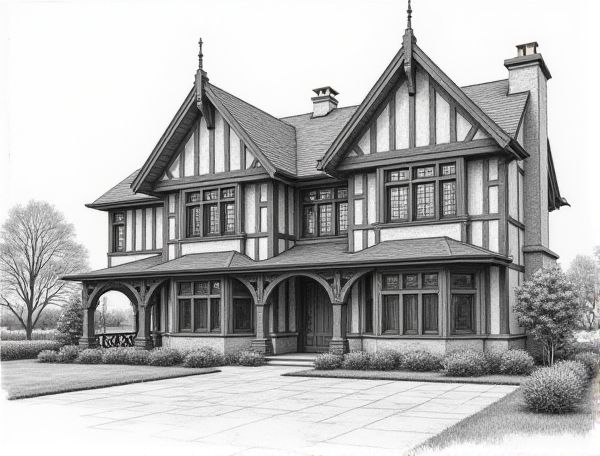
Photo illustration: Tudor home design with Decorative half-timbering
Tudor home design is characterized by its distinctive decorative half-timbering, which adds warmth and historical charm to your home's exterior. Explore the full article to discover how these intricate wood patterns can transform your living space.
Introduction to Tudor Home Design
Tudor home design features steeply pitched gable roofs, decorative half-timbering, and tall, narrow windows with small panes, reflecting medieval English architecture. This style emphasizes craftsmanship with brick, stone, and stucco exteriors, creating a timeless, storybook aesthetic. Interior elements often include exposed wooden beams, grand fireplaces, and intricate woodwork, enhancing the warm, cozy atmosphere.
Key Features of Tudor Architecture
Tudor architecture showcases distinctive steeply pitched gable roofs, decorative half-timbering, and tall, narrow windows with small panes, creating a historic and charming aesthetic. Prominent stone chimneys with intricately patterned brickwork enhance both the exterior design and functional warmth of the home. Your Tudor-style home embraces craftsmanship and medieval-inspired details, offering timeless elegance and structural character.
The History of Decorative Half-Timbering
Decorative half-timbering originated in medieval Europe, particularly during the 15th and 16th centuries, showcasing exposed wooden frames filled with plaster or brick. This architectural technique was both functional and aesthetic, offering structural support while creating intricate patterns that define Tudor and Elizabethan styles. Understanding this history allows you to incorporate authentic elements into your home design that celebrate traditional craftsmanship and timeless appeal.
Materials Used in Tudor Half-Timbering
Tudor half-timbering primarily uses oak wood for the exposed timber framework, providing structural support and aesthetic appeal, while the infill panels are commonly made from wattle and daub, brick, or plaster. These materials create a distinctive textured appearance, combining durability with historical authenticity in Tudor-style home design.
Exteriors: Incorporating Decorative Timber Designs
Incorporating decorative timber designs into home exteriors enhances aesthetic appeal while providing natural insulation and durability. Utilizing sustainably sourced wood with intricate patterns or cladding options can elevate facade textures and create a warm, inviting ambiance that seamlessly blends with outdoor landscapes.
Interior Elements of Tudor Homes
Tudor homes feature rich interior elements such as exposed wooden beams, intricate plasterwork, and large, leaded glass windows that enhance their historical charm. Your space benefits from heavy wooden doors, wrought iron hardware, and cozy fireplaces with stone or brick surrounds, creating a warm, inviting atmosphere. Incorporating these authentic Tudor interior details elevates the character and timeless appeal of your home.
Color Palettes for Authentic Tudor Style
Choose rich, earthy tones like deep reds, forest greens, and warm browns to capture the authentic Tudor style color palette. Your home design can be enhanced with natural wood finishes and textured plaster walls that complement these traditional hues. These colors evoke historical charm and create a cozy, inviting atmosphere in any Tudor-inspired interior.
Modern Adaptations of Tudor Half-Timbering
Modern adaptations of Tudor half-timbering incorporate sleek, energy-efficient materials such as fiber cement and engineered wood to emulate the classic exposed timber look while enhancing durability and sustainability. Contemporary designers blend traditional geometric patterns with minimalist interiors to create a harmonious fusion of historic charm and modern aesthetics in residential architecture.
Renovation Tips for Tudor Homeowners
Preserving the authentic timber framing while upgrading insulation and energy-efficient windows enhances both the charm and functionality of your Tudor home. Incorporate period-appropriate fixtures and avoid overly modern materials to maintain historical integrity during your renovation.
Enhancing Curb Appeal with Tudor Accents
Tudor accents elevate your home's exterior by incorporating distinctive half-timbering, steeply pitched gables, and leaded glass windows, creating a timeless and elegant look. These architectural features increase curb appeal by adding texture, depth, and historical character that attract potential buyers or simply impress visitors. Installing authentic Tudor elements enhances value and establishes a strong, welcoming first impression for your property.
 homedesy.com
homedesy.com